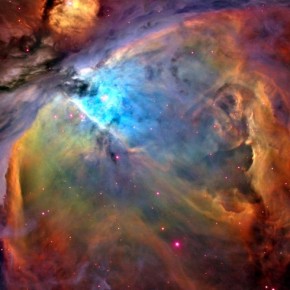A few weeks ago, Dr. Eliot Quataert from UC Berkeley came to Oakland’s Chabot Space and Science Center to tell a modern fairy tale: the scientific story of how we, and our world, came to be.
He started by putting up some photos, illustrating the scale of the universe. Our solar system’s one light year across, compared to our whole galaxy, a hundred thousand light years across. The Milky Way contains a hundred billion stars and planets, and weighs roughly a trillion times the mass of our sun. Our nearest neighbor galaxy, Andromeda, is three million light years away.
Dr. Quataert shared quotes from Carl Sagan and Douglas Adams dealing with our relative insignificance in the face of the vast universe. We can certainly feel very small when we think about being out on the edge of our galaxy, in the Milky Way’s suburbs. And, as large as the Earth seems to us humans, light can travel around our planet in just a tenth of a second.
Back in 1929, astronomer Edwin Hubble first observed the universe expanding. Everything seemed to constantly move away from everything else. In more recent years, scientists speculated that gravity would eventually slow the expansion of the universe. However, data showed that the expansion was actually accelerating. For this to happen, according to Quataert, 74 percent of the universe must be composed of something we do not yet understand that can overcome gravity. For now, we refer to it as ‘dark energy.’
The Big Bang theory and subsequent expansion of the universe has predicted many phenomena we see in the universe today. For example, we observe background leftover microwave radiation, a holdover from the smooth early universe. Also, that our world contains, as expected, roughly 74 percent hydrogen, 24 percent helium, and two percent heavier elements, including nitrogen, oxygen, and iron.
Hydrogen and helium, with their simpler atomic structures, would have formed three minutes after the Big Bang. Over time, as the world cooled, some matter condensed into heavier elements. 13.8 billion years ago, when data suggest the Big Bang occurred, the laws of physics could have been completely different. Perhaps the universe could have been infinite, even then, and it would not make sense to speak of its ‘center.’
The universe as a whole moves fast enough to escape the gravitational forces holding the matter together, although localized, small, matter-rich areas are imploding and pulling together. Some of these areas are clusters of hundreds or thousands of galaxies, with stars orbited by planets. Currently scientists estimate that ten percent of the universe’s stars have planets one to two times Earth’s size, and have identified 3,000 exoplanets beyond our solar system.
We’ve come a long way from the Big Bang and the days of hot, dense, undifferentiated matter. But, no one yet knows why our universe expands, or where we’re headed. While we wait, though, we can take Dr. Eliot Quataert’s insights and share them in our conversations with others curious about the universe.
Cristina Deptula may be reached at cedeptula@sbcglobal.net and welcomes other science writing gigs, especially paying ones!


Have you ever thought about creating an ebook or guest
authoring on other blogs? I have a blog based upon on the same
information you discuss and would love to have you share
some stories/information. I know my audience would value your work.
If you are even remotely interested, feel free to send me an e
mail.
I am really loving the theme/design of your website.
Do you ever run into any internet browser compatibility issues?
A few of my blog audience have complained about my site not operating correctly in Explorer but looks great in Opera.
Do you have any tips to help fix this issue?
Just desire to say your article is as amazing.
The clearness on your submit is just nice and that i can assume you are knowledgeable on this
subject. Fine along with your permission let me to grasp your feed to keep updated
with forthcoming post. Thank you a million and please keep up the enjoyable work.
Sweet blog! I found it while browsing on Yahoo News.
Do you have any tips on how to get listed in Yahoo News?
I’ve been trying for a while but I never seem to get there! Thanks
Just desire to say your article is as surprising.
The clearness in your post is just excellent and i could assume you’re an expert on this subject. Well with your permission let me to grab your feed to keep up to date with forthcoming post. Thanks a million and please keep up the enjoyable work.
Hello to all, how is everything, I think every one is getting more from
this site, and your views are fastidious in favor of new people.
Excellent pieces. Keep posting such kind of information on your site.
Im really impressed by it.
Hey there, You have performed an incredible job. I’ll certainly digg it and in my opinion recommend to my friends. I’m
sure they will be benefited from this site.
It’s an remarkable post for all the internet people; they will obtain advantage
from it I am sure.
Pingback: Synchronized Chaos July 2013 – Perspective and Scale | Synchronized Chaos